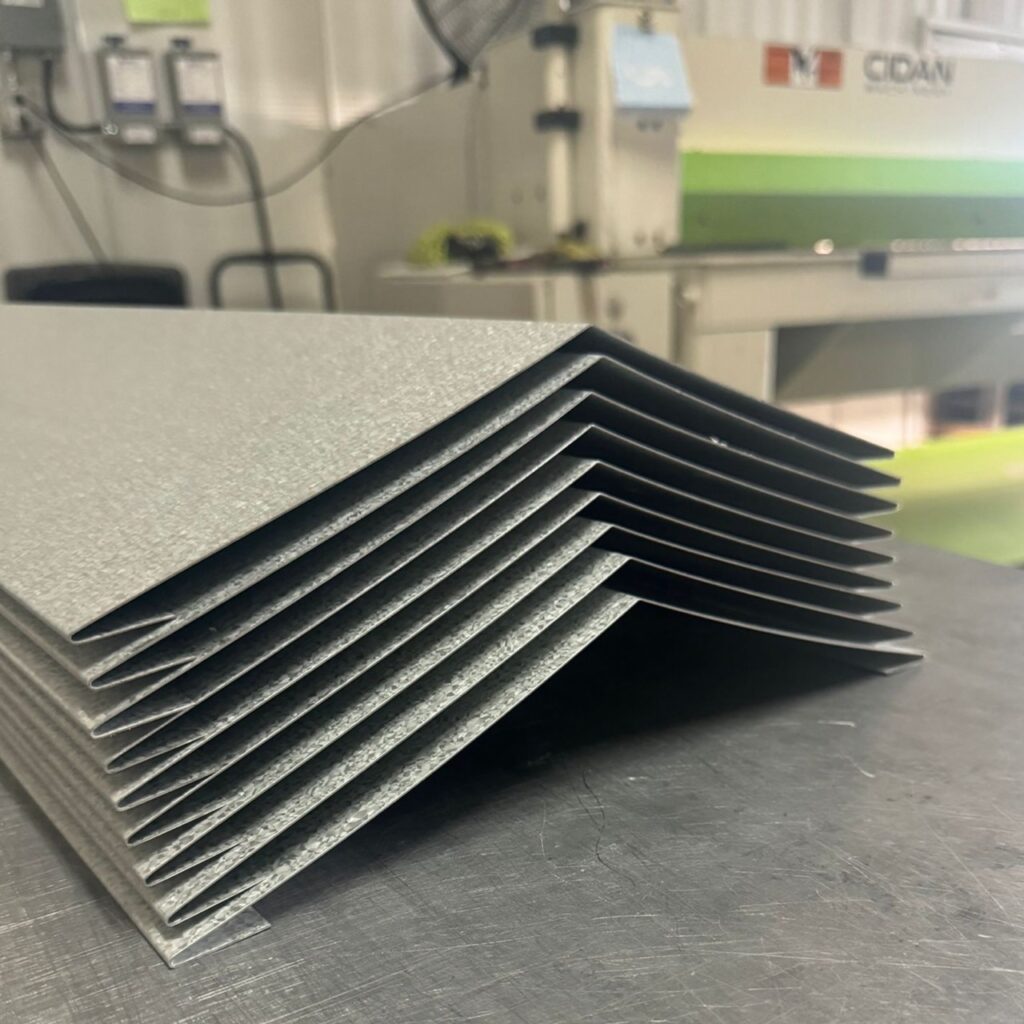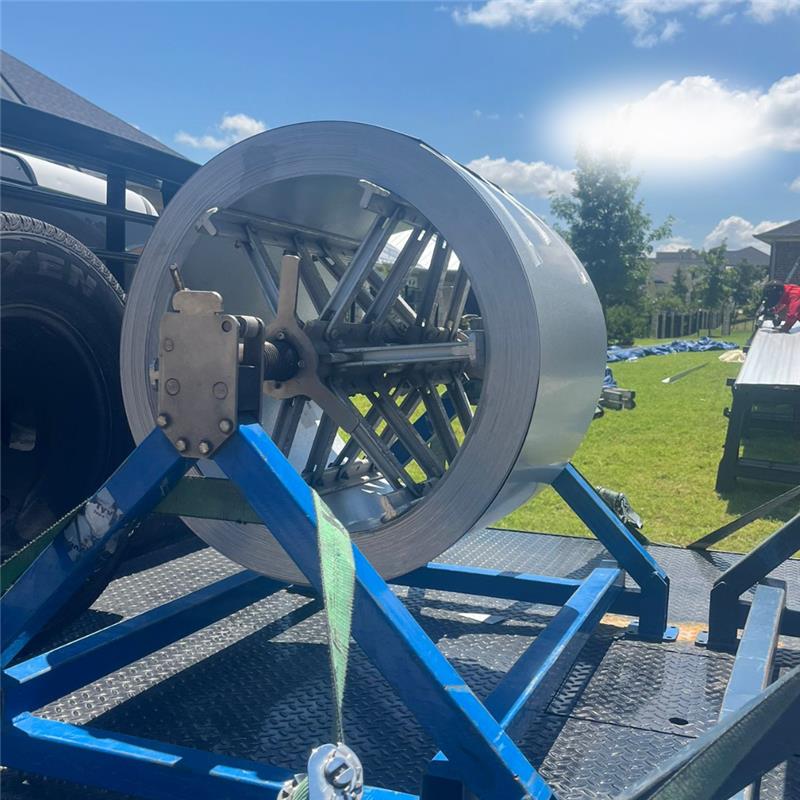Have you ever noticed those clean, finished lines running along the peak of your roof? Those aren’t just for looks. The ridge cap on your roof plays a critical role in your home’s overall health and comfort. Like the crown on a king’s head, a quality roof ridge cap not only completes the look of your roofing system but also provides essential protection and ventilation benefits that many homeowners overlook.
In San Antonio’s challenging climate, where summer heat can be relentless and humidity levels fluctuate dramatically, proper roof ventilation isn’t just a nice-to-have feature—it’s absolutely essential. At the heart of this ventilation system sits the humble yet mighty roof ridge cap, working silently to protect your home and extend the life of your entire roofing system.
Table of Contents
What Is a Roof Ridge Cap and Why Does It Matter?
The roof ridge cap is the finishing material that covers the peak where two roof slopes meet. While it might seem like just a decorative finishing touch, this component serves critical functional purposes that directly impact your home’s durability and comfort.
Why ridge caps matter:
- They provide a weatherproof seal at the most vulnerable point of your roof
- They allow for proper airflow while keeping out pests and debris
- They complete the aesthetic appearance of your roofing system
- They protect the underlying structure from moisture infiltration
Think of your ridge cap as the keystone in an arch—without it, the entire structure becomes compromised. In San Antonio, where we experience everything from scorching heat to occasional heavy downpours, a properly installed ridge cap is your first line of defense against the elements.
The Science Behind Roof Ventilation
To understand why a quality roof ridge cap is so important, we need to grasp the basic science of how roof ventilation works. Proper roof ventilation follows a simple principle: cool air enters at the eaves (the lowest part of the roof), warms up as it rises through the attic space, and then exits at the ridge (the highest point).
This natural airflow, known as the “stack effect,” creates a continuous current that:
- Reduces heat buildup in your attic during summer months
- Prevents moisture accumulation that can lead to mold and mildew
- Extends the life of your roofing materials by maintaining moderate temperatures
- Improves energy efficiency by reducing the load on your HVAC system
The ridge cap, especially when combined with a ridge vent system, plays a crucial role in this ventilation process by providing an exit point for hot, moist air. Without a properly functioning ridge cap and ventilation system, this air becomes trapped, creating a host of problems we’ll explore in the next sections.
How Quality roof Ridge Caps Prevent Moisture Damage
One of the most important functions of a well-designed roof ridge cap is moisture control. In San Antonio’s climate, where humidity can be high and temperature swings create perfect conditions for condensation, moisture management is essential for protecting your home’s structure.
When warm, moist air from your living spaces rises into your attic, it needs somewhere to go. A quality ridge cap working in conjunction with proper ventilation allows this moisture to escape rather than condensing on your rafters, insulation, or roof decking.
Consequences of poor ridge cap performance include:
- Wood rot affecting your roof’s structural components
- Mold and mildew growth that can affect indoor air quality
- Insulation damage reducing your home’s energy efficiency
- Ice dam formation in colder weather (yes, even in San Antonio we occasionally face freezing conditions)
- Premature shingle failure due to excessive heat and moisture
By investing in a quality roof ridge cap properly installed by experienced professionals, you’re essentially buying insurance against these expensive and potentially dangerous issues.
Energy Efficiency Benefits of Proper roof Ridge cap Ventilation
Did you know that your roof ridge cap can actually help lower your energy bills? It’s true! In San Antonio’s hot climate, proper attic ventilation facilitated by a quality ridge cap system can significantly reduce cooling costs.
During summer months, temperatures in a poorly ventilated attic can soar to 150°F or higher. This extreme heat radiates downward into your living spaces, forcing your air conditioning system to work overtime. A properly installed ridge cap ventilation system can reduce attic temperatures by 50°F or more, creating substantial energy savings.
The energy-saving benefits include:
- Reduced air conditioning costs during summer months
- Less strain on your HVAC system, extending its lifespan
- More consistent indoor temperatures throughout your home
- Potentially qualifying for energy efficiency rebates or incentives
- Lowering your home’s overall carbon footprint
For many homeowners, the energy savings alone can offset the cost of upgrading to a quality ridge cap ventilation system within just a few years.
Signs Your roof Ridge Cap Needs Attention
How do you know if your roof ridge cap is functioning properly? Here are some warning signs that might indicate issues with your ridge cap that require professional attention:
Visual indicators:
- Missing or damaged shingles along the ridge line
- Visible gaps between roof ridge cap pieces
- Cracked or curling ridge cap material
- Rust or corrosion on metal ridge caps
- Plant growth or debris accumulation at the ridge
Internal indicators:
- Excessive heat in your attic, particularly near the ridge
- Moisture or water stains on rafters near the peak
- Mold or mildew growth in attic spaces
- Higher than normal energy bills
- Uneven temperatures throughout your home
If you notice any of these signs, it’s wise to have a professional roofing contractor perform an inspection. Catching ridge cap issues early can prevent more expensive repairs down the road.
Metal vs. Asphalt Ridge Caps: Making the Right Choice
When it comes to ridge caps, material choice matters significantly—especially in San Antonio’s climate. The two most common options are asphalt and metal ridge caps, each with their own advantages.
Asphalt Roof Ridge Caps:
Pros:
- More affordable upfront cost
- Match traditional asphalt shingle roofs aesthetically
- Relatively easy installation
- Available in various colors to match existing roofs
Cons:
- Typically shorter lifespan (15-20 years)
- Less resistant to extreme weather conditions
- Can curl, crack or deteriorate in intense heat
- May require more frequent maintenance
Metal Roof Ridge Caps:
Pros:
- Exceptional durability (40+ years in many cases)
- Superior resistance to San Antonio’s heat and occasional severe weather
- Better long-term value despite higher initial cost
- Enhanced ventilation options with specialized ridge vent systems
- Environmentally friendly and often made with recycled materials
Cons:
- Higher initial investment
- Installation requires specialized skills and equipment
- May not match the aesthetic of traditional shingle roofs
For San Antonio homes, metal ridge caps often provide the best long-term performance due to their durability in our hot climate and resistance to UV degradation. However, the right choice depends on your specific roofing system, budget, and long-term plans for your home.
roof Ridge Cap Installation Best Practices
Proper installation is just as important as choosing quality materials for your roof ridge cap. Even the best ridge cap products will fail prematurely if installation best practices aren’t followed. Here’s what quality installation should include:
Professional installation standards:
- Precise measurements and cutting for perfect fit
- Proper overlap between ridge cap pieces (typically 2-3 inches minimum)
- Appropriate fastening techniques specific to the ridge cap material
- Correct placement of nails or screws to prevent leaks
- Application of sealant in specific locations as needed
- Integration with any ridge vent systems
Why professional installation matters:
- Ensures proper waterproofing at the most vulnerable point of your roof
- Maximizes ventilation efficiency
- Prevents wind uplift that can damage or dislodge ridge caps
- Creates a uniform, aesthetically pleasing appearance
- Often required to maintain manufacturer warranties
Remember, your roof ridge is constantly exposed to the elements and typically experiences the strongest wind forces on your roof. Professional installation provides peace of mind that this critical component will stand up to San Antonio’s weather challenges.
Maintaining Your Roof Ridge Cap in San Antonio’s Climate
Our unique South Texas climate presents specific challenges for roofing systems. To ensure your ridge cap continues performing optimally, regular maintenance is essential.
Seasonal maintenance recommendations:
Spring:
- Check for debris accumulation that might block ventilation
- Inspect for damage from winter weather or spring storms
- Ensure ridge caps remain properly secured
- Clear any pollen or seed pods that might retain moisture
Fall:
- Remove leaves and debris before winter
- Check for any damage from summer heat and storms
- Ensure ridge vent openings are clear for proper winter ventilation
- Inspect for signs of pest intrusion (birds, squirrels, etc.)
Professional maintenance:
While some visual inspections can be done from the ground using binoculars, a professional inspection of your ridge cap every 2-3 years is recommended. Professional roofers can:
- Safely access the ridge for close inspection
- Identify early signs of deterioration not visible from the ground
- Make minor repairs before they become major problems
- Assess ventilation performance with specialized tools
- Document the condition for insurance and warranty purposes
Common roof Ridge Cap Problems and Solutions
Even with the best materials and installation, ridge caps can develop issues over time. Here are common problems and their solutions:
Problem: Wind damage Solution: Replace damaged sections and consider upgrading to wind-resistant ridge cap designs with enhanced fastening systems.
Problem: Water infiltration Solution: Identify the source of leaks (often at joints or fastener points) and repair or replace affected sections, ensuring proper overlaps and sealant application.
Problem: Inadequate ventilation Solution: Upgrade to a ridge vent system that increases airflow while maintaining weather protection.
Problem: Cracking or splitting Solution: Replace damaged ridge caps before moisture can penetrate to underlying structures.
Problem: Biological growth (algae, moss, etc.) Solution: Professional cleaning and application of preventative treatments, along with improving ventilation to create drier conditions.
Professional assessment is crucial for determining the best approach to these issues, as temporary fixes often lead to more extensive damage and higher repair costs down the road.
How Professional Ridge Cap Installation Saves Money Long-Term
While DIY ridge cap installation might seem tempting to save money, professional installation typically provides better long-term value. Here’s why:
Financial benefits of professional installation:
- Extended product lifespan due to proper techniques and materials
- Reduced risk of leaks that could cause expensive structural damage
- Optimal ventilation performance leading to energy savings
- Maintained manufacturer warranties that often require professional installation
- Proper integration with other roofing components
A quality professional installation might cost more upfront, but typically saves money over the life of your roof by preventing premature failures and maximizing energy efficiency. In San Antonio’s challenging climate, this professional advantage becomes even more significant.
Ridge Cap Innovations for Texas Homes
The roofing industry continues to evolve, with new ridge cap technologies specifically designed for challenging climates like ours in South Texas. Here are some innovations worth considering:
Advanced ventilation systems:
- High-volume ridge vents that maximize airflow while preventing water intrusion
- Solar-powered ridge vent fans that boost air movement during peak heat periods
- Smart ridge vents that adjust airflow based on temperature and humidity conditions
Enhanced materials:
- Impact-resistant ridge caps designed to withstand hail and debris
- Cool-roof ridge cap technologies that reflect more solar radiation
- Composite materials that combine the durability of metal with the aesthetics of traditional shingles
Integrated solutions:
- Ridge caps with built-in solar collectors for energy generation
- Lightning protection integration for enhanced home safety
- Rainwater collection systems that interface with ridge caps and gutters
These innovations offer exciting possibilities for San Antonio homeowners looking to maximize their roof’s performance while addressing our region’s specific climate challenges.
Ridge Caps and Your Home’s Curb Appeal
Beyond their functional importance, ridge caps play a significant role in your home’s appearance. A quality ridge cap provides a clean, finished look that enhances curb appeal and can even increase property value.
Aesthetic considerations include:
- Profile design that complements your home’s architectural style
- Color coordination with the main roofing material
- Texture and dimension that add visual interest
- Uniformity and alignment that signal quality construction
When upgrading your ridge cap, work with professionals who understand both the technical and aesthetic aspects of this important roofing component. The right ridge cap not only protects your home but serves as the crowning touch that completes your roof’s appearance.
Conclusion: The Value of Quality Ridge Caps for San Antonio Homes
The humble roof ridge cap deserves more attention than it typically receives. As we’ve explored throughout this article, this seemingly simple component plays a crucial role in your home’s ventilation, energy efficiency, structural integrity, and appearance.
In San Antonio’s challenging climate, where summer heat puts extreme stress on roofing systems and proper ventilation is essential year-round, investing in quality ridge caps installed by experienced professionals is not just a good idea—it’s a necessity for protecting your home and maximizing your roofing investment.
Whether you’re building a new home, replacing an aging roof, or simply upgrading components to improve performance, pay special attention to your ridge cap system. The modest additional investment in quality materials and professional installation will pay dividends through enhanced durability, improved energy efficiency, and peace of mind for years to come.
FAQs
Q1: How long should a quality roof ridge cap last in San Antonio’s climate?
A properly installed asphalt ridge cap typically lasts 15-20 years in our climate, while metal ridge caps can last 40+ years. Factors affecting longevity include material quality, installation technique, maintenance practices, and exposure to extreme weather events.
Q2: Can I install a ridge cap myself, or should I hire a professional?
While DIY installation is possible for experienced homeowners, professional installation is strongly recommended. Ridge caps protect the most vulnerable area of your roof, and improper installation can lead to leaks, reduced ventilation, and voided warranties. Professional installers have the tools, techniques, and experience to ensure proper performance.
Q3: How can I tell if my ridge cap is properly ventilated?
Signs of proper ridge ventilation include consistent attic temperatures (ideally no more than 10-15°F above outside temperature on hot days), absence of moisture or condensation on attic surfaces, and visible airflow through ridge vents. A professional energy audit can provide definitive assessment of your ventilation effectiveness.
Q4: Does the color of my ridge cap affect my home’s energy efficiency?
Yes, lighter-colored ridge caps reflect more solar radiation, which can improve energy efficiency, especially when combined with proper ventilation. However, the ventilation function of the ridge cap generally has a more significant impact on energy efficiency than color alone.
Q5: Can I upgrade my ridge cap without replacing my entire roof
In many cases, yes. Ridge caps can be replaced independently of the main roofing surface, especially if the existing roof is in good condition. However, if your roof is nearing the end of its useful life, it’s often more cost-effective to replace both components simultaneously.
Q6: How does a roof ridge cap differ from a normal roof shingle?
Ridge caps are specially designed to bend over the peak of the roof while maintaining water resistance. They’re typically thicker, more flexible, and have different dimensions than standard roofing shingles. Some ridge caps also integrate ventilation features not found in regular shingles.
Q7: What maintenance does a roof ridge cap require?
Regular maintenance includes visual inspection for damage or displacement, clearing debris that could block ventilation, checking for loose fasteners, and ensuring proper sealing at joints. Professional inspection every 2-3 years is recommended to catch issues not visible from the ground.
Q8: Can improving my ridge cap ventilation really lower my energy bills?
Yes, proper ridge ventilation can significantly reduce attic temperatures, which decreases heat transfer to living spaces and reduces the load on your air conditioning system. Many homeowners report 10-15% reductions in cooling costs after improving ridge ventilation.
Q9: Are there special considerations for metal roofs and their ridge caps?
Metal roofs require specifically designed ridge caps that accommodate thermal expansion and contraction while maintaining watertight seals. These specialized components often include features like closure strips, butyl tape, and specific fastening systems not used with asphalt shingles.
Q10: How do I know if my existing ridge cap needs replacement?
Warning signs include visible damage (cracks, gaps, lifting edges), water stains in the attic near the ridge, excessive attic heat, missing granules (for asphalt caps), rust or corrosion (for metal caps), or age beyond the manufacturer’s recommended lifespan. When in doubt, professional inspection can provide a definitive assessment.
——————-
With more than 50 years of experience in manufacturing and metal roof installation, Fasteel – Metal Roof Solutions designs, manufactures, and distributes metal roofing products, including coils, flat sheets, panels, trims, and accessories. Our services include breaking metal, on-site manufacturing, small batch production, and plans and blueprint interpretation to ensure the most accurate estimate. With manufacturing facilities and warehouses in San Antonio and Houston, we cover the entire Dallas, Austin, San Antonio, and Houston metroplex area. In addition, we have a fleet of high-tech roll formers that allows us to expand our coverage to anywhere in the continental United States of America.






